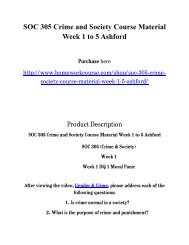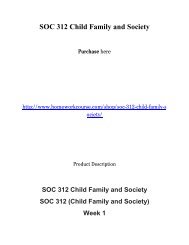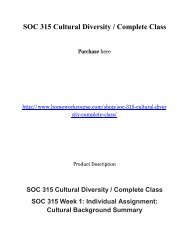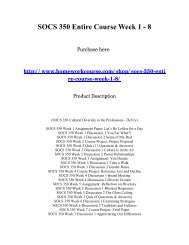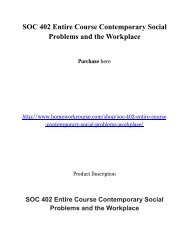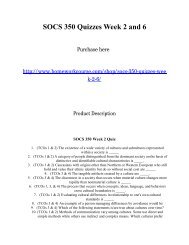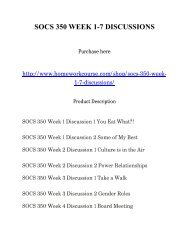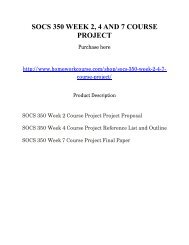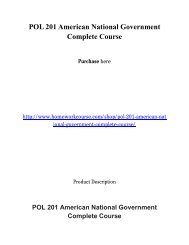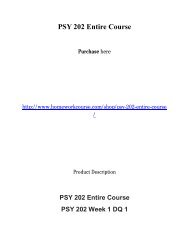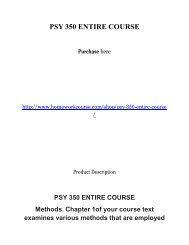PPA 605 _Negotiation Bargaining & Conflict Management_ Entire Course
You also want an ePaper? Increase the reach of your titles
YUMPU automatically turns print PDFs into web optimized ePapers that Google loves.
<strong>PPA</strong> <strong>605</strong> (<strong>Negotiation</strong> <strong>Bargaining</strong> & <strong>Conflict</strong><br />
<strong>Management</strong>) <strong>Entire</strong> <strong>Course</strong><br />
Purchase here<br />
http://www.homeworkcourse.com/shop/ppa-<strong>605</strong>-negotiationbargaining-conflict-management-entire-course/<br />
Product Description<br />
<strong>PPA</strong> <strong>605</strong> (<strong>Negotiation</strong> <strong>Bargaining</strong> & <strong>Conflict</strong><br />
<strong>Management</strong>) <strong>Entire</strong> <strong>Course</strong>
<strong>PPA</strong> <strong>605</strong> (<strong>Negotiation</strong> <strong>Bargaining</strong> & <strong>Conflict</strong><br />
<strong>Management</strong>) <strong>Entire</strong> <strong>Course</strong><br />
Elements of <strong>Negotiation</strong> and <strong>Bargaining</strong> Skills<br />
Discuss the following statements then respond<br />
to at least two of your fellow students’ posts.<br />
1. Discuss the Five Elements of <strong>Negotiation</strong>s<br />
and provide at least one ex<strong>amp</strong>le of how<br />
each are used in the negotiation process.<br />
2. Identify the Five <strong>Negotiation</strong> Skills needed<br />
in order to perform successful<br />
negotiations.<br />
3. Define Rational Choice theory and discuss<br />
how it relates to the negotiation process.<br />
4. Discuss how the Dual-Concern Model and<br />
Big Five Personality Dimensions facilitate<br />
recognizing bargaining styles and how<br />
such styles impact behaviors and<br />
strategies in a negotiation.
The <strong>Negotiation</strong> Process: Four Stages<br />
Discuss the following statements then respond<br />
to at least two of your classmates’ postings.<br />
1. Define the Four Stages of the <strong>Negotiation</strong><br />
Process and discuss what changes have<br />
taken place in the negotiation tactics since<br />
the 1950s.<br />
2. Explain why the Best Alternative to a<br />
Negotiated Agreement (BATNA) is<br />
important in preparing the negotiation.<br />
3. Discuss the difference between tangible<br />
and intangible priorities and why ground<br />
rules are important when both parties are<br />
amenable to negotiate.<br />
4. Discuss whether the Good Guy / Bad Guy<br />
Routine is useful in negotiations; whether<br />
impasses are fatal to negotiations; and if<br />
arbitration is a sign that negotiations have<br />
failed.
Distributive <strong>Bargaining</strong><br />
Discuss two of the following statements then<br />
respond to at least two of your classmates’<br />
postings.<br />
1. Define and explain the purpose of the Five<br />
Distributive <strong>Bargaining</strong> <strong>Negotiation</strong> Skills.<br />
2. Discuss the “Zone of Possible Agreement”<br />
(ZOPA) and why some experienced<br />
negotiators consider it critically important<br />
to make the opening offer.<br />
3. Define the following terms: relational<br />
information, substantive information,<br />
equality norm, and equity norm and explain<br />
how they relate to the distributive<br />
bargaining process.<br />
Integrative <strong>Bargaining</strong><br />
Discuss two of the following statements then<br />
respond to at least two of your classmates’
postings. Try to respond to students who pick<br />
different statements.<br />
1. Discuss the differences between<br />
integrative and distributive bargaining and<br />
the conditions in which either or both are<br />
used in the negotiation process.<br />
2. Describe Thompson’s Pyramid Model and<br />
its relationship to parties in bargaining<br />
situations, and why it is useful to the<br />
integrative bargaining process.<br />
3. Discuss the advantages and disadvantages<br />
of the Categorization and Interest-Based<br />
<strong>Bargaining</strong> (IBB) Methods and which<br />
method you would be more likely to use in<br />
a negotiating situation and why.<br />
4. Discuss the purpose that Full,<br />
Open-Throttle <strong>Negotiation</strong>s (FOTN) serves<br />
in bargaining; why recognition of<br />
establishing value for the long-term<br />
relationship is a positive approach to<br />
beginning the negotiations process; and
asking circular questions and packaging<br />
issues are helpful in the negotiations.<br />
5. Explain why Mary Parker Follet’s ex<strong>amp</strong>le<br />
of two sisters cutting an orange in half is a<br />
classic model of poor integrative<br />
negotiations.<br />
Gaining Leverage in <strong>Negotiation</strong>s<br />
Discuss two of the following statements then<br />
respond to at least two of your classmates’<br />
postings. Try to respond to students who pick<br />
different statements.<br />
1. Define the terms power and leverage and<br />
what is the most essential source of<br />
bargaining strategy in any negotiation<br />
process.<br />
2. Define French and Raven’s Five Sources of<br />
Power (1956) and provide an ex<strong>amp</strong>le of
how each is effectively used in a<br />
negotiating situation.<br />
3. Discuss why it is useful to convince others<br />
of the strength of your BATNA and how<br />
shakers and auditors can negotiate<br />
effectively.<br />
4. Explain how the lack of ethos can derail<br />
negotiations; why humor is considered a<br />
value in persuasive negotiations; and facial<br />
expressions considered relevant to<br />
effective negotiations.<br />
Strategies and Tactics<br />
Discuss one of the following statements then<br />
respond to at least two of your classmates’<br />
who chose the other statement.<br />
1. Discuss the Five <strong>Negotiation</strong> Strategies for<br />
Various Situations.<br />
2. Think about a situation in your life or work<br />
in which you need to choose a negotiation<br />
strategy. First answer the questions below
egarding the “key elements” of the<br />
situation, i.e., time, information, and power,<br />
and then answer the strategy questions<br />
which can help you select a preferred<br />
overall strategy to use as you start<br />
negotiating.<br />
<br />
Is there a deadline that will affect the<br />
timing of your bargaining?<br />
<br />
What is your BATNA and demonstrate<br />
how it is calculated? What is your best<br />
estimate of the other party’s<br />
BATNA? Is your BATNA your starting<br />
or walk-away point?<br />
<br />
What other information do you need to<br />
collect before you start the<br />
negotiation?<br />
<br />
Is the power between the two sides<br />
balanced or who appears to initially<br />
have the advantage?<br />
If several economic issues are<br />
involved, could you develop a MESO or
Economic Matrix of alternatives to offer<br />
to the other side?<br />
<br />
Will negotiations primarily focus on one<br />
number, such as price, and thus,<br />
should you consider a strategy of<br />
“Increments of Concession?”<br />
Impasse and Alternative Dispute Resolutions<br />
(ADR)<br />
Discuss two of the following statements then<br />
respond to at least two of your classmates’<br />
postings. Try to respond to students who<br />
picked different statements.<br />
1. Define what is meant by the term,<br />
Alternative Dispute Resolution (ADR) and<br />
discuss the differences, advantages and<br />
disadvantages between arbitration and<br />
mediation.<br />
2. Discuss the following statutes that govern<br />
the arbitration of disputes: Taft-Hartley
Act 1947; Railway Labor Act (RLA) 1926;<br />
and the Federal Arbitration Act (FAA) 1925.<br />
3. Outline the procedures in arbitration and<br />
mediations. Also describe the roles of the<br />
arbitrator and the mediator in the<br />
negotiation and bargaining process.<br />
4. Describe the roles and functions of the<br />
American Arbitration Association (AAA)<br />
and the Federal Mediation and Conciliation<br />
Service (FMCS) and the procedures<br />
involved when parties have reached an<br />
impasse and are in need of an alternative<br />
dispute resolution (ADR).<br />
Ethics, Fairness, and Trust in <strong>Negotiation</strong>s<br />
Discuss two of the following statements then<br />
respond to at least two of your classmates’<br />
postings. Try to respond to students who<br />
picked different statements.
1. Discuss how skills in ethics, fairness, and<br />
trust can be a part of the negotiation<br />
process even though some negotiation<br />
tactics challenge those values.<br />
2. Identify the Five Bases for Trust and<br />
explain why they are important in the<br />
negotiation process.<br />
3. Describe Kant’s Ethics of Principle and<br />
Mill’s Ethics of Consequences<br />
philosophies and discuss which theory you<br />
would be more incline to use in a<br />
negotiating situation.<br />
4. Discuss the Functionalist Model, Mutual<br />
Trust Principle, and the test for meeting<br />
procedural fairness of a negotiation.<br />
Chapter Case: To Agree or Not to Agree – That<br />
is the Question
Assume the role of one of the five parties in the<br />
case as you form your answers. Respond to<br />
at least two of your classmates’ postings.<br />
1. What reasons do you have for remaining<br />
with the negotiations at this point?<br />
2. Describe three tactics you can use after<br />
agreement is reached and your bargaining<br />
partner asks for one more thing.<br />
3. Detail the parts, i.e., elements of an<br />
agreement template and explain why it<br />
helped you in this negotiation.<br />
4. Identify an ideological issue in this<br />
negotiation and explain why it is more<br />
difficult than financial negotiations to<br />
resolve.<br />
Keeping a Client<br />
Answer the following questions and apply the<br />
Five <strong>Negotiation</strong> Skills to an actual negotiation
case. Respond to at least two of your<br />
classmates’ postings.<br />
1. How would an agreement template<br />
facilitate closing this deal?<br />
2. How can you react to the particular demand<br />
for limiting your time at the site, which is<br />
totally unacceptable, but not risk losing the<br />
deal?<br />
3. What technique can you sue to move Ms.<br />
White past her apparent problems with<br />
your engagement?<br />
4. How can you avoid the psychological trap<br />
of agreeing to an arrangement guaranteed<br />
to just to keep this client?<br />
5. What techniques can you use during this<br />
impromptu negotiation to build a<br />
relationship with Ms. White?<br />
Closing the Deal
Discuss two the following statements then<br />
respond to at least two of your classmates’<br />
postings. Try to respond to students who<br />
picked different statements.<br />
1. Describe the Five <strong>Negotiation</strong> Skills in<br />
Closing the Deal and indicate how you<br />
would, or have used them in an actual<br />
bargaining and negotiation situation<br />
specifying the issues, actors, and<br />
outcomes.<br />
2. Explain the purpose of an agreement<br />
template and why a written agreement best<br />
serves to generate commitment to the<br />
agreement.<br />
3. Discuss why silence can be an effective<br />
response to a request for a last-minute<br />
concession and when the<br />
nickel-and-diming approach can be utilized<br />
most effectively.<br />
4. Discuss the emotional issues that may<br />
cause stalemates; sources of conflict<br />
spirals; psychological entrapments;
difficulties in managing<br />
ideologically-based conflicts; and why<br />
sequential decision-making processes are<br />
helpful in resolving decision-making<br />
conflicts.<br />
Settling a Lawsuit<br />
Review the Learning Exercise: Settling a<br />
Lawsuit in Chapter 8, page 218 of your text.<br />
Discuss two of the following statements then<br />
respond to at least two of your classmates’<br />
postings. Try to respond to students who<br />
picked different statements.<br />
1. Discuss the ethical values you would use in<br />
this negotiation and the criteria you would<br />
use to make decisions.<br />
2. Discuss how you would determine whether<br />
the negotiation is conducted with<br />
substantive fairness.<br />
3. Identify what concealment behaviors would<br />
be ethical and unethical in this negotiation.
4. Describe the manner in which you would<br />
determine if you are using fair procedures<br />
and creating trust in this negotiation case.<br />
The Influences of Culture and Gender on<br />
<strong>Negotiation</strong>s<br />
Discuss two of the following<br />
statement. Assume the role of one of the five<br />
parties in the GLOBE Project Study case as<br />
you form your answers. Respond to at least<br />
two of your classmates’ postings.<br />
1. Select two of the dimensions of culture,<br />
identified by either Hofstede or the GLOBE<br />
Project Study, and discuss how best to<br />
negotiate a deal favorable to an<br />
organization’s relationship in an Eastern<br />
European and an Asian country.<br />
2. Select two clusters from the GLOBE<br />
Project Study groups and describe how the<br />
history and traditions of those countries’
clusters are reflected in their cultural<br />
dimensions. Indicate how this information<br />
can help you in the negotiation process.<br />
3. Explain why in Cross-Cultural<br />
<strong>Negotiation</strong>s, the heuristic of availability is<br />
a culturally significant bias in a negotiation<br />
to sell a computer in a highly feminine<br />
society.<br />
4. Discuss the differences between<br />
promotion focus, prevention focus and<br />
shadow negotiation, and which type is a<br />
negotiator from a collectivist society more<br />
likely to have, and why?<br />
<strong>PPA</strong> <strong>605</strong> Complete <strong>Course</strong> Assignment<br />
<strong>PPA</strong> <strong>605</strong> Week 1 Assignment House for Rent<br />
You have been relocated by your employer to a<br />
new city for an assignment that will probably<br />
last for two years. You do not want to sell
your home – a four-bedroom, two-bath Tudor –<br />
so you decide to rent it. A friend of yours in<br />
real estate has a potential lessee for you to<br />
meet. He is a 30-something single doctor<br />
beginning a two-year residency in the local<br />
hospital. You have some concerns about a<br />
single guy living in your house and taking care<br />
of it the way you would, but you agree to meet<br />
with him and possibly negotiate a lease. You<br />
must address the following:<br />
1. Describe the interested parties and their<br />
prospective goals in this negotiation.<br />
2. Analyze the parties’ dependencies and<br />
motivations and propose four options in<br />
this negotiation so that all parties’ goals<br />
are met.<br />
3. Discusses a bargaining behavior of a<br />
skilled negotiator that would be most<br />
advantageous to you in this negotiation.<br />
4. Explains why collaboration is the only<br />
bargaining style applicable to this
negotiation, and identify the collaborative<br />
goals.<br />
5. Identify if any of the participants entered<br />
the negotiations with a cognitive bias.<br />
Discuss the implications.Your paper<br />
should be four- to- five- pages in length<br />
(not including title and reference pages).<br />
Format your paper according to APA style<br />
as outlined in the Ashford Writing Center,<br />
and utilize three to four scholarly sources<br />
in addition to the textbook. Be sure to cite<br />
your sources within the body of your paper<br />
and on the reference page.<br />
<strong>PPA</strong> <strong>605</strong> Week 2 Assignment<br />
Buying a House<br />
Imagine you are a public administrator who<br />
has just been promoted to a higher position<br />
but must relocate to another city and purchase<br />
a different home. Using the five distributing
argaining skills, present the steps and<br />
various aspects you would consider<br />
implementing in buying a house. Be sure to<br />
address the following:<br />
1. Analyze the bargaining situation and<br />
whether or not it is distributive. If so,<br />
determine the reservation price.<br />
2. Present the initial offer you would make<br />
and apply bracketing to achieve your target<br />
price of $310,000.<br />
3. Indicate and frame the norms you would<br />
utilize in presenting your initial offer.<br />
Your paper should be four- to- five- pages in<br />
length (not including title and reference<br />
pages). Format your paper according to APA<br />
style as outlined in the Ashford Writing Center,<br />
and utilize three to four scholarly sources in<br />
addition to the textbook. Be sure to cite your<br />
sources within the body of your paper and on<br />
the reference page.
<strong>PPA</strong> <strong>605</strong> Week 3 Assignment<br />
Leveraging Power from BATNA<br />
Review the Learning Exercise: Unhappy<br />
Co-Owners and address the following:<br />
1. Assuming your Best Alternative to a<br />
Negotiating Agreement (BATNA) is letting a<br />
court sell the property, discuss how it may<br />
help you reach an agreement. Recommend<br />
other strategies that you could use to<br />
accomplish a successful negotiation.<br />
2. Discuss your power sources and your<br />
co-owner’s power sources in this<br />
negotiation, and analyze how you can<br />
strengthen your power position.<br />
3. Propose a logical and an emotional<br />
argument to persuade your co-owner to<br />
agree to a deal.
4. Describe a nonverbal communication<br />
technique that you will use to persuade<br />
your co-owner that your proposal is a<br />
win-win proposition.<br />
5. Describe a threat you can make that would<br />
force your co-owner to make concessions.<br />
Your paper should be four to five pages in<br />
length (not including title and reference<br />
pages). Format your paper according to APA<br />
style as outlined in the Ashford Writing Center,<br />
and utilize three to four scholarly sources in<br />
addition to the textbook. Be sure to cite your<br />
sources within the body of your paper and on<br />
the reference page.<br />
<strong>PPA</strong> <strong>605</strong> Week 4 Assignment<br />
The Common Driveway Case
After reading Chapter 7 in the text, address the<br />
following in a four- to five-page paper that is<br />
formatted according to APA style:<br />
1. Explain whether the dispute is at an<br />
impasse or not and if any party is<br />
experiencing any settlement pressures.<br />
2. Discuss the use of arbitration or mediation<br />
if the negotiation between the Wilsons and<br />
Greens reaches an impasse. Should they<br />
consider arbitration or mediation to resolve<br />
their differences? Why or why not?<br />
3. Analyze other hybrid forms of alternative<br />
dispute resolution (ADR) that are available<br />
and should be considered if negotiations<br />
fail to produce a settlement.<br />
Your paper should be four to five pages in<br />
length (not including title and reference<br />
pages). Format your paper according to APA<br />
style as outlined in the Ashford Writing Center,<br />
and utilize three to four scholarly sources in<br />
addition to the textbook. Be sure to cite your<br />
sources within the body of your paper and on
the reference page.<br />
The book is negotiating essentials by carrel m.<br />
R & heavrin c I don’t have the book and can<br />
you # the pages<br />
<strong>PPA</strong> <strong>605</strong> Week 5 Assignment<br />
Withholding Information Case<br />
Read the Withholding Information Case on<br />
pages 193-194 and address the following:<br />
1. Identify ethical systems that may guide the<br />
parties to a negotiation.<br />
2. Examine the substantive fairness of the<br />
negotiation.<br />
3. Examine the procedural fairness of the<br />
negotiation.<br />
4. Differentiate between concealment<br />
behaviors in negotiations that are ethical<br />
and those that are unethical among the<br />
parties in the negotiation.
5. Evaluate how the parties can learn to create<br />
trust in a one-shot negotiation and in a<br />
long-term negotiation relationship.<br />
Your paper should be four to five pages in<br />
length (not including title and reference<br />
pages). Format your paper according to APA<br />
style as outlined in the Ashford Writing Center,<br />
and utilize three to four scholarly sources in<br />
addition to the textbook. Be sure to cite your<br />
sources within the body of your paper and on<br />
the reference page.<br />
Carefully review the Grading Rubric for the<br />
criteria that will be used to evaluate your<br />
assignment.<br />
<strong>PPA</strong> <strong>605</strong> Final paper (<strong>Bargaining</strong> and<br />
negotiation situation)
Consider a real life bargaining and negotiation<br />
situation that involves two parties and the<br />
multiple issues to be negotiated that has<br />
already occurred, currently in progress, or will<br />
occur in the near future in your personal life or<br />
at work. Be sure to address the following:<br />
1. Describe the situation and negotiation<br />
environment.<br />
2. Identify the parties (e.g., yourself, the<br />
persons on your side, and/or the opposing<br />
parties) including the bargaining positions.<br />
3. Present the type of third party intervention<br />
and procedures if required, (e.g.,<br />
arbitration or mediation).<br />
4. Explain how the Best Alternative to a<br />
Negotiated Agreement (BATNA) is derived.<br />
5. Evaluate the theoretical models, methods,<br />
sources of power, and analytical<br />
procedures required to be utilized in the<br />
negotiation process.
6. Examine the mechanics of the procedures<br />
in terms of framing, packaging, use of<br />
questions, and types of proposals.<br />
7. Assess the strategies utilized and the<br />
results achieved and/or anticipated in the<br />
settlement.<br />
Writing the Final Paper<br />
The Paper:<br />
1. Must be 10 double-spaced pages in length<br />
and formatted according to APA style as<br />
outlined in the approved APA style<br />
guide. Title, reference, and any exhibits or<br />
appendices are not counted in the paper<br />
length.<br />
2. Must include a cover page that includes:<br />
<br />
Name of paper<br />
<br />
Student’s name<br />
<br />
<strong>Course</strong> name and number<br />
<br />
Instructor’s name<br />
<br />
Date submitted
3. Must include an introductory paragraph<br />
with a succinct thesis statement.<br />
4. Must address the topic of the paper with<br />
critical thought.<br />
5. Must end with a conclusion paragraph that<br />
reaffirms your thesis.<br />
6. Must use at least five scholarly sources,<br />
including a minimum of two from the<br />
Ashford University Library.<br />
7. Must document all sources in APA style, as<br />
outlined in the Ashford Writing Center.<br />
8. Must include a separate reference page,<br />
formatted according to APA style as<br />
outlined in the Ashford Writing Center.<br />
9. Must be written in the third person.<br />
FacebookTwitterGoogle+Share




